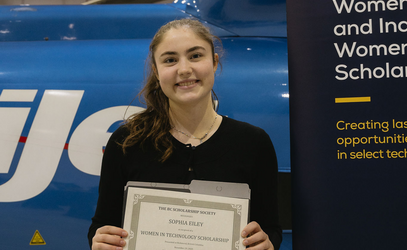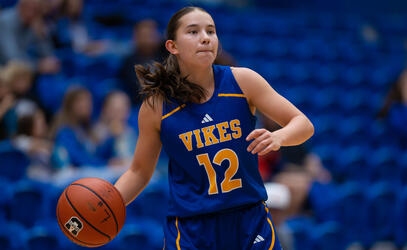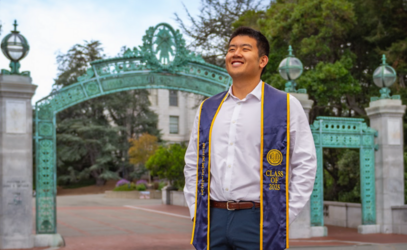This article originally appeared in the Winter 2018 issue of School Ties.
by Kyle Slavin
If you were given the challenge of redesigning an important urban space, what would you do? This was the question alumnus Alec Johnston ’98, a Senior Planner with the City of Victoria, posed to a group of creative Middle School students.
Under the umbrella of their City 20/20 projects, Grade 6 students were tasked with learning about and re-imagining Centennial Square in the heart of downtown Victoria.
“The project brought together Humanities, Science, Economics, Math, Design and Information Technology and students worked together to come up with innovative solutions to urban space issues,” Alec says. “It was pretty open-ended and allowed for a lot of different approaches, so I was interested to see how the kids could tackle the problems, ideas and concepts.”
The annual City 20/20 project has Grade 6 students exploring topics such as water usage, energy consumption, waste management, transportation, food security and affordable housing as they relate to urbanization. Each year, a different area is examined and has in the past involved the mayors of Oak Bay, Saanich and Victoria – in addition to professionals like Alec.
“It was a really great experience. I was really impressed with the outcomes that each group came up with,” Alec says, “and I was also impressed with the students themselves and the clear thought they put into their projects.”
Experts in our Community
To kick off the project, he took the students on a tour of Centennial Square and outlined important aspects of city planning they need to consider when redesigning a space.
“Having him get involved gave them insights they wouldn’t normally have had,” says teacher and Middle School program specialist Mrs. Julie Harris. “This is what I love about having experts in our community come in – it makes it real for the kids. It showed them that they were doing something that wasn’t just from a textbook. It helps them see that their work is important beyond the classroom. This is the type of work adults do, and that helps them take this a lot more seriously.”
Julie says one of the best moments for her as a teacher was seeing Alec meet with the students partway through the process. He sat down with each group and asked tough questions about their projects that showed them this was serious business.
“He came in and looked at each project and, straight away, I saw the students sit up straight like, ‘He works at City Hall. We have to know what we’re talking about here,’” she says. “Alec helped them raise the bar because he made them think about this in reality. ‘You want a rooftop hot tub and fire pit? Well what are the safety issues that come with that?’ He treated these projects as something that could come to fruition in Centennial Square and challenged the students to really think about each decision they made.”
Alec says it was important for the kids to understand how cities are built, how decisions are made around investments in their environment, and the impact a new building can make on the livability of a city.
“It was important for them to really think about all the things that are important to a city planner,” he says. “They worked really hard on their projects and so I showed them that respect and treated them as I would treat anyone who comes in to see me with a development proposal or with ideas around city-building.”
“He treated us like adults, almost like we’re actually proposing the plans to him to redesign Centennial Square in real life like he would’ve done with his co-workers,” says Middle School student Tyson C. “We knew we had to be realistic.”
“Since we were presenting to Alec, everyone was like, ‘I want to get this right, I really have to work hard, I really have to get this done,’” adds Ava O. “People were really focused because they didn’t want to make a fool of themselves in front of someone from City Hall.”
At the end of the project, students revisited City Hall and Centennial Square to present their proposals to Alec. Students also held an exhibition at the Middle School to show their parents and schoolmates their proposals for the redesigned space.
“I liked that this was a pretty hands-on project and we got to work in a group,” says Tyson. “I feel like, even though it was a very creative, fun project with not many boundaries, we were all good at staying focused. It’s fun to not have many rules because you get to be creative with it and I think that helped us stay really interested.”
Project-based Learning
Project-based learning is a big part of the curriculum at the Middle School. Projects allow students to follow their curiosity and work to answer a driving question from a real-world scenario. Projects are often interdisciplinary and involve bringing in experts, like Alec, to help inform the students’ work.
“It supports the shifting role of the teacher,” Julie says. “Long gone are the days when the teacher is the know-it-all expert in the room and just imparts this knowledge to these empty vessels. Information is prolific. Students can find information on anything, they can learn anything they want and so our role is shifting in that we are trying to guide them in this process, developing the skills that are going to help them be lifelong learners.”
Julie hopes City 20/20 continues to grow. She wants to see the projects become even more interdisciplinary – incorporating more subjects like music and art – and attract more alumni and community members to lend their expertise.
“Any expertise that someone can share with us makes a huge difference because it adds such value to the educational experience of our students,” she says. “You don’t learn and practise those subjects in isolation in the real world. If you study art, it’s within a culture or a time of history. As adults, we experience art, science, math, music together. I understand why curriculums have isolated them, but when we have opportunities like City 20/20 to put it all together in a context that makes sense for the students, it really is a special learning experience.”
Alec says the value for him comes from reconnecting with the school and getting to give back to the current students. “I just felt it was important because it helps to enrich the student experience to have alumni get involved where they can.”
But further to that, Alec says he also got some great ideas from our Grade 6 students on revamping Centennial Square that could actually be used by the City of Victoria’s planning department.
“Some of the solutions they came up with on how to improve the space were really creative ideas, and I ended up passing them along to our design team. It was clear the students put a lot of time and thought into their ideas, and there are some that have real potential to be considered when we upgrade Centennial Square.”


